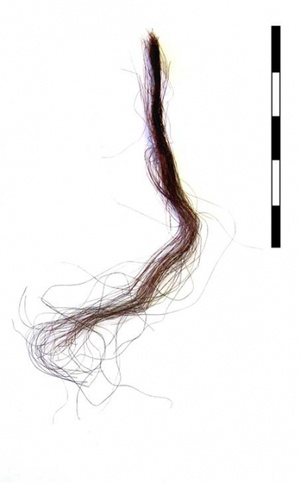- Overview
-

The stable isotope composition of animal tissues reflects the values of ingested dietary protein during life, providing a direct measure of diet. δ13C values are used to discriminate between marine and terrestrial dietary protein sources, and δ15N values can be used to determine the trophic level of the protein consumed. Carbon and nitrogen data from contemporary marine and terrestrial fauna provide a baseline for the interpretation of human stable isotope data.
Still in its initial phases, work to date has included the analysis of permafrost-preserved human hair and animal fur samples from several sites in Yukon-Kuskokwim delta and Nunivak Island. Preliminary findings suggest evidence for a potential dietary shift amongst Alaska's early Inuit groups, and have implications for our understanding of human adaptation in the Arctic, and regional and temporal complexity in early Eskimo subsistence.
- Funding and Publications
-
Funding
A pilot study for this project received partial funding from a Carnegie Trust for the Universities of Scotland Research Travel Grant, and full funding was recently granted as part of a large AHRC funding bid for the Nunalleq Project Understanding Cultural Resilience and Climate Change on the Bering Sea through Yup'ik Ecological Knowledge, Lifeways, Learning and Archaeology (co-I with Dr. Rick Knecht [PI] and Dr. Charlotta Hillerdal [co-I]).
Publications
- Britton, K., Knecht, R., Nehlich, O., Hillerdal, C., Davis, RS. & Richards, MP. (2013). 'Maritime adaptations and dietary variation in prehistoric Western Alaska: Stable isotope analysis of permafrost-preserved human hair'. American Journal of Physical Anthropology, vol 151, no. 3, pp. 448-461., http://dx.doi.org/10.1002/ajpa.22284
[Online] DOI: 10.1002/ajpa.22284
- Britton, K., Knecht, R., Nehlich, O., Hillerdal, C., Davis, RS. & Richards, MP. (2013). 'Maritime adaptations and dietary variation in prehistoric Western Alaska: Stable isotope analysis of permafrost-preserved human hair'. American Journal of Physical Anthropology, vol 151, no. 3, pp. 448-461., http://dx.doi.org/10.1002/ajpa.22284
